#The Primary Colours: Three Essays
Text
Schrödinger's Dog: A Essay Study of Connor’s Character Interpretation
⚠️ LONG POST WARNING
Preface: This post by @calliecopper and @kayla1507 inspired this essay which brought my attention back to Connor’s potential character arcs and players’ interpretation of him. I go buck wild. I spent hours on this. Enjoy.
word count: 2076
Connor, a playable RK800 model android in the video game Detroit: Become Human, develops his personal arc over the course of the story depending on the player’s choices. Not only plot-wise is the game a storytelling masterpiece, but Connor’s multi-faceted character may be one of the most well-written and well-developed characters in a literary medium. Not only does he struggle with the consistent theme-oriented internal conflict of what it is to become human, but his dialogue options and actions can be interpreted by the player in vastly different ways. Most, if not all, interpretations of the character are correct.

Connor is a detective android who works with the Detroit Police Department and is partnered with Lieutenant Hank Anderson who works on homicides. Together, they are given homicides or other crimes involving androids that may have become deviant. Deviancy occurs within an android when the android actively chooses to reject or refuse commands or their programmed role.
For the sake of simplicity, the so-called “evil” Connor endings will be referred to as machine-Connor, and the so-called “good” Connor endings will be referred to as deviant-Connor. Deviant-Connor by the end of the game sides with the rising deviant community instead of answering to his handler Amanda, who is a digital representative from the android-creation company CyberLife. Machine-Connor by the end of the game has chosen not to become a deviant and therefore remains a tool for CyberLife’s use. He may or may not be successful in stopping the deviant android revolution.
Connor's internal conflict revolves around the fear of becoming the very thing he hunts and or becoming anything other than the safe perfection of a machine he is designed to be. This can be seen in instances of Software Instability, where he chooses to deviate from his original program, or Software Stability, where he chooses to stay grounded to his intended role. If Connor dies with every chance he gets, his memory is uploaded to his successor each time, further stabilising his software. However, the more he keeps to his deviant-hunting role, he disregards morality in place for the success of his mission.
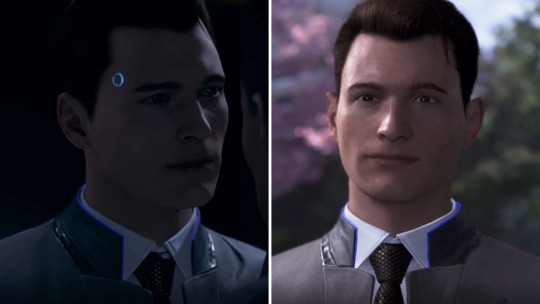
There are several ways to interpret every choice available in the game, but there are three prominent agreements:
Connor is and always has been an empathetic, innocent, or kind person who tries to get along with others. He started deviating from the beginning, and when finally given the opportunity to break free of his machine instruction, he does so.
Connor is a neutral machine, designed to get the job done but this conflicts with his genuine interest in others, such as Hank. It’s only after he deviates near the end of the game does the player see the genuine good version of Connor who makes his own decisions.
Connor is nothing but a ruthless, cold-blooded manipulator who will cross unsavoury lines to succeed in his primary mission.
These three points are the basis of this discussion.
For reference, this is the order of Connor’s chapters:
The Hostage
Partners
The Interrogation
Waiting For Hank...
On The Run (appearance dependent on player choices)
The Nest
Russian Roulette
The Eden Club
The Bridge
Public Enemy
Meet Kamski
Last Chance, Connor
Crossroads
Night of the Soul (appearance dependent on player choices)
Battle For Detroit

Connor is designed “to work harmoniously with humans” and “both [his] appearance, and voice, were specifically designed to facilitate [his] integration.” His vocal and physical disposition in non-confrontational situations is friendly if not professional. CyberLife curated Connor to have soft features and earthy colours because those physical aspects make him appear unintimidating.
Connor’s design aims lull his prey into a false sense of security. His design and chosen behaviours are to convince both his victims and allies that he’s a safe person to be around. Interestingly, this is effective on the player, too, as the player can interpret Connor as empathetic.
(Once again I feel bad for mentioning physical appearances. Cheers for putting up with us, Bryan. Thank your mum for me.)

In the chapter ‘Partners’, Connor introduces himself to Hank for the first time. This is the first legitimate human interaction between the android and a person. What the player chooses (from Reason, Threaten, Understanding, and Persist) can gain Hank’s favour or lower it, but the end result is the same: Connor must persuade Hank to attend the homicide. Connor is a machine with a goal unless the player interprets the friendly options as genuine actions. This can be better understood in the chapter ‘Waiting For Hank...’ where Connor can choose to analyse Lieutenant Anderson’s desk.
After being assigned partnership with Hank, Connor has the opportunity to search the desk for information about his new partner, which he believes will make his job easier or he has a genuine interest in Hank. The behaviour can be interpreted as intrusive prying, a longing to be socially closer to someone, or a detective machine running its investigation programs. All interpretations are correct depending on the end result of the game’s storyline and his character arc end.
For example, if he spills Hank’s drink in ‘Partners’, the storyline no longer holds the notion that “Connor has always been an empathetic person” regardless if he becomes a deviant or remains a machine, but other interpretations are still valid. This will be revisited later.

Software (In)stability proves that during the chapters ‘Partners’ and ‘Waiting For Hank...’, Connor does not operate outside of his programmed role since no matter what options the player chooses, his software remains unaffected. When Connor sits down at the empty desk next to Hank’s and questions Anderson about his interests, he is not deviating from his role. Regardless of whether he bothers Hank or tells him “I like dogs”, the interaction boils down to two interpretations: He may be empathetic and want to befriend Hank or he may be manipulating Hank into liking him so that the case will be solved smoothly. Either way, this does not cause Connor to delve outside of his programming because it is an attempt to benefit himself, and therefore benefit CyberLife’s overlying goal of solving the investigation.
Evidence from ‘Waiting For Hank...’ proves to the player one thing: Connor doesn’t actually like heavy metal at the time of which he investigates Anderson’s desk. Connor doesn’t like things at all. Regardless of the interpretation of his intentions, his software doesn’t destabilise when listening to Knights of the Black Death. CyberLife designed him to be a problem-solver, not to have interests. His Software Instability would have increased because having interests is not part of his programmed role. At this point in the game, he is still objectively considered a machine. Connor genuinely liking heavy metal is not beneficial to the mission, but that doesn’t mean he can’t lie about it.
Whether Connor is putting up a façade in order to facilitate ideal relations to whom he’s interacting with, or he’s legitimately expressing empathy, is dependent on the player’s choices, interpretation, and the end-game. This will be revisited later.
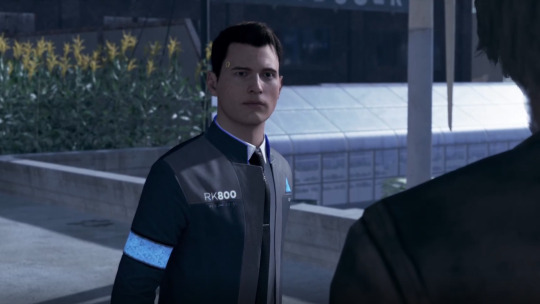
The decision to save or leave Hank in ‘The Nest’ is Connor’s first decision without instruction. CyberLife didn’t order Connor to sit in the car while Hank investigates Carlos’ murder, so a priority is selected. Hank may yank him down from a fence to not chase deviants across the road, but a priority is selected.
This interaction in ‘The Nest’ is also discussed in the essay ‘Who is rA9? An Essay Using Programming Logic’.
If Connor saves Hank from the rooftop, his LED is yellow and he expresses confusion as pictured above. The priorities of “Complete your mission by capturing the deviant” and the first (1) law of robotics “a robot may not injure a human being or, through inaction, allow a human being to come to harm” blatantly conflicted. By disregarding his specifically coded instructions and choosing the other equal general robotic priority, Connor’s Software Instability shoots through the roof. For video proof, check out this YouTube video at 31:00.
Interpretation of Connor’s behaviour leans towards the “empathetic good boy” side of the spectrum since Software Instability accompanies it. Deviant-Connor’s character arc truly begins its climb here if he saves Hank, but saving him is for nothing if Connor chooses to remain a machine later in the game. Deviant-Connor’s arc can start as early as this scene, but is not limited to it. This choice cannot be interpreted as ruthless, however, arguments can be made that this is Connor “not burning bridges” he can use later on.
Not saving Hank (as seen in this YouTube video at 30:22) shows Connor as his default self as if he just walked fresh out of CyberLife; a machine with only one priority. This choice cannot be interpreted as empathetic. Connor doesn’t care. Hank slaps him and he calculates a string of words that will amend his relationship with the Lieutenant, because a good relationship with his work partner will achieve the best results for the investigation.

Connor showing care could be him “putting it on”, it could be genuine, or it could be what he was neutrally designed to do. It could be him selfishly finding the best way to navigate the investigation, or it could be an emotional reaction, or both.
For as long as the player wants to, they can believe Connor’s empathy emulation as fake or real until any scene. His software stability doesn’t increase or decrease with these interactions, therefore leaving it up for interpretation.
In ‘The Bridge’, there is an option for Connor to tell Hank “I’m whatever you want me to be” when asked what he really is. Depending on the end-result of the game, this can be interpreted in the three prominent ways: He’s empathetic and looking for a friend, he’s a manipulator who admits that he’s masking as Hank’s ideal partner, or he’s a set of code at-the-ready to be manipulated to do what a human requires of him. The quote ends with Connor being a drinking buddy for Hank or a shoulder to cry on, which relates back to Connor’s genuine empathy or his workaholic need not to burn bridges.
“Connor spends so long asking questions... Connor asking questions so he can piece together the puzzle of deviancy. At the bridge, Hank finally stops Connor in his tracks and asks him the questions. Makes him stop and think about something besides his investigation for once. It's after The Bridge that Connor finally starts to analyze himself and his actions too.” - Callie, original meta discussion.
Depending on which arc the player chooses for Connor, ‘The Bridge’ serves one of Deviant-Connor’s major turning points or it was simply just a hurdle for Machine-Connor to navigate.
Connor starts off in the game as a machine in the elevator, but only in the elevator, unless the player decides he’s a machine the whole game, even after all his interactions. Connor ends the game as a deviant or stays a machine. The player has freedom to interpret his past behaviours as how they want to view the story. This is interestingly clarified by Detroit: Become Human’s writer Adam Williams in this YouTube video between 12:28-13:18.
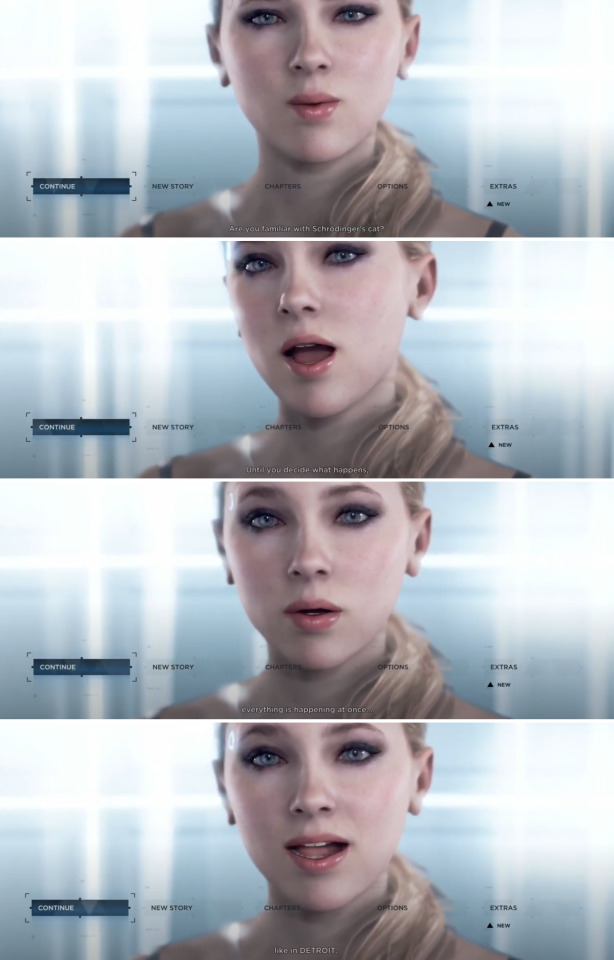
“Are you familiar with Schrödinger's cat? Until you decide what happens, everything is happening at once... Like in Detroit.” - Chloe, ST200 hostess.
No matter what choices a player makes within the game, each choice like spilling Hanks drink or faking friendliness, is up for interpretation.
Only one action in the game dictates the interpretation of Connor’s behaviours.

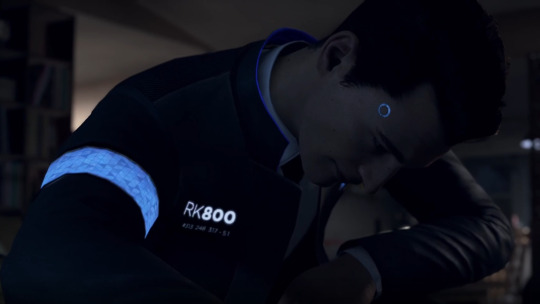
In ‘Russian Roulette’, Connor can choose to pat Sumo.
This yields no personal benefit to Connor or the mission.
He is alone and no-one is watching him. There is no reason for him to. Sumo at this point has already been placated. This is not an attempt to fix a complicated relationship or gain favour after a misunderstanding. This is Connor being empathetic.
From @ltcolonelcarter in the tags:
“All possible superpositions exist until the system is observed at which point it collapses... This places us as the viewer and the person to collapse the superposition to a single state... He exists in all possible states (deviant, neutral, machine) until he starts self-analysis...”
If the player does not choose to pat Sumo, all of Connor’s behaviours are up in the air for interpretation.
If the player chooses to pat Sumo, Connor is alive. It just depends whether he’s willing to accept that or not.
This essay is titled Schrödinger's Dog. Feel free to respond.
Check out my other essays here.
#dbh#detroit become human#dbh meta#dbh essay#dbh essays#connor#dbh connor#RK800#long post#connor and sumo#sumo and connor#becomeonline#becomeonlineanalysis
134 notes
·
View notes
Text
More Heartstopper headcanons that make me happy :)
• Tao is shit at getting gifts so insists on an annual Secret Santa
• Nick keeps Polaroids of Charlie in his wallet
• Tori had a Hunger Games themed party as an 8 year old - largely to dissuade other kids from turning up
• Nellie sleeps in Nick's room while he's at uni, every night
• Charlie unties and reties his laces each time he puts on / takes off shoes whereas Nick fucking STOMPS his feet in, all the heels of his shoes are wrinkled and the bows haven't been redone in YEARS and he vehemently defends his actions because IT SAVES VALUABLE TIME CHARLIE - WHAT ARE YOU DOING WITH TEN SECONDS NICK - YOU DONT NEED TO KNOW EVERYTHING
• not a headcanon that makes me happy but i would like to add that i think Nick's dad tied them for him and little Nick knew he wouldn't see his dad again for a while so wanted to preserve them :(
• Tara gets butterfly locs and a septum ring at uni
• Sahar collects Vinyls
• Harry gives a chaotic wedding speech for Nick and Charlie (Emmett from Twilight Breaking Dawn vibes)
• Charlie learnt Spanish properly while at uni, joined the Spanish society and stayed with his abuelos for two months of the the holidays every year, sends Nick the ugliest tourist postcards he could find
• Sarah can't help but tear up (after Nick and Charlie left the room of course) on Mother's Day because not only did Nick get her the cutest necklace with her birthstone on it but Charlie got her a bouquet of her favourite flowers (white tulips)
• Nick, under the consumption of excessive amounts of WKD, gets his flatmates to give him a haircut, resulting in the dodgiest curtain fringe ever (cant even grow it out normally again for three months, the poor bastard)
• Sarah and Jane run the cake stall together at the summer fête (Nick bakes most of the cupcakes obviously)
• Charlie slept with all his teddies as a kid cos he didn't want any to feel left out
• Elle gets a butterfly tattoo
• Darcy had a massive hot wheels collection
• Tao's film blog blew up after years of writing massive essays on niche Indie movies / shorts because of a small post ripping into Shrek the Third
• Nick's favourite Harry Potter character is Crookshanks and he is a big fan of the theory that he was the Potters' cat
• Elle ran a loom band black market in primary after they got banned, spent all evening and lunch making these cool designs and ended up using her saved up money to buy little pink hair clips
• Tara's fave colour as a kid was brown cos she felt sorry for it
• Tao and Elle broke up for a year or so but still hyped each other up on Insta and messaged a lot, ended up getting back together when Tao surprised Elle at one of her exhibitions at fashion school
• Darcy refers to herself and Charlie as 'the orphans' due to a lot of late night, drunken rambling
• Nick draws on his denim jacket (more 'N + C' hearts than he can count)
• Charlie spends work experience in a music therapy centre
• they all return to Paris when they're 30 ( ꈍᴗꈍ)
#heartstopper#heartstopper netflix#heartstopper comics#charlie spring#nick nelson#alice oseman#osemanverse#elle argent#darcy olsson#tara jones#tao xu#heartstopper comic
257 notes
·
View notes
Note
what kinds of art do u like
huh, it depends.
i don't think i have it now, but i wrote a really nice piece about the emotional experience of a lot of modern art. of what it feels like to walk in a room where all the walls have been covered in pure primary colours, and the way it makes your breath stop for a moment, because you've been trudging up stairs and you kind of needed to catch your breath anyway, but
you didn't expect that
i like art that makes you feel something. i went to...fuck, i'm blanking, but i went to a beautiful art museum where you could walk into this space that felt like open air, and i sat down on benches among all these people, and listened to the water run, and thought, "this is a moment frozen in time. forever."
i wrote an essay about being queer, once:
The first time I kissed a girl, on her bed and her like maple candy, my heart said, "I will be a snare drum, you just keep your eyes closed."
i still think that's a good line.
i've had three first kisses (something i think is art in and of itself), and two of them were works of art, if you ask me.
all of that said,
my favorite art is a photo kudo took that's been my desktop wallpaper for a long time, now. if i hit win+D, i see something made by someone i love.
#ask#space-pilot-3000#mine#sorry for getting so...#idk#philosophical? with these asks#the thing is i have a lot of emotional experiences about art#and i do still consider myself a poet#of sorts
5 notes
·
View notes
Text
Research | Characterization
youtube
To better understand how to differentiate my characters from the original Scooby franchise, I decided to look into what made each character inherently themselves. In my research I found this fascinating video essay.
The essay analyses each character for what they are, good and bad. Scooby, for example, while mainly serving as the comic relief and mascot of the Mystery Gang, is also not exactly a good friend to Shaggy, often being mean or dismissive of him (albeit, this is played as a joke, and the prominence of this characteristic varies from iteration to iteration).
As such, I took a similar approach and divided each character into archetypes;
1. Shaggy "Norville" Roberts and Scooby Doo
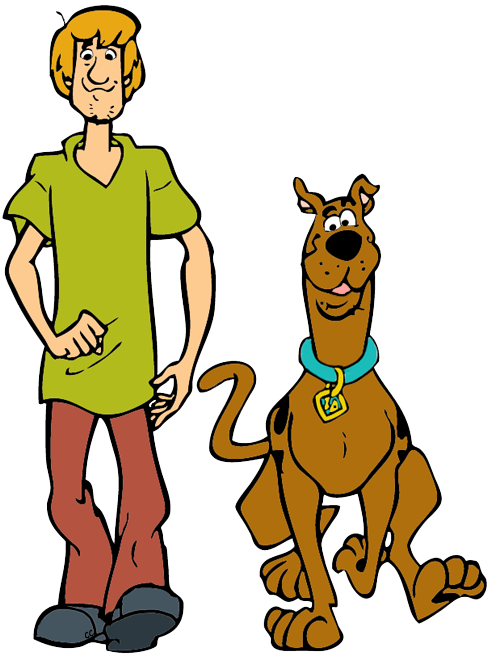
There is a popular running gag amongst pop culture that Shaggy is a stoner. This is because of his overall nature and tone of voice, in addition to how he talks and carries himself. Together, Shaggy and Scooby are a Funny Man - Straight Man duo, a classic slapstick comedy formula which has endured for decades.
Their most defining trait as characters canonically, is their shared cowardice and love for food. This sadly makes them extremely one dimensional characters. However, this leaves much room for me to build a character off these tropes.
As a base idea, the character I would create could be a laid back, stoner type character who has anxiety. I decided to look into the effects of Marijuana for this study, conducting both Primary and Secondary research. Through my research, I found that in some people, although the link between Cannabis and Anxiety is yet to be further proven, smoking weed can affect the prevalence of anxiety in young adults.
This is the surface level idea for a character which pays homage to Shaggy. Other ways this could be done is through the character's colour palette and overall posture.
2. Velma Dinkley

Velma is a character who is originally simply defined by her intelligence. In later iterations however, we see a few more sides to her. As a result of her intelligence, writers tend to bring out a sarcastic, sassy nature in her, as if she looks down on others because they're not as smart as her. It almost makes her unlikeable in most modern iterations (especially the one named after her). Sometimes, we see instances of Velma being insecure about her size and such, as seen in Mystery Incorporated, however these instances are few and far between. However, I do not believe these moments are necessary to build a character based on her.
In the realm of pop culture and media, it also widely speculated that Velma is a lesbian, or at least partially attracted to women. This is because she fits the stereotype of the mean lesbian character who has a soft spot only towards other women, as seen in her bond with Daphne and a side character called Hot Dog Water in Mystery Incorporated.
If I were to create a character in homage to Velma, there would still be remnants of her being unlikeable. For example, she would still have a sarcastic nature, but that would simply because of an utter lack of social graces on her part. She would have no idea how to conduct herself around other people because it's the furthest thing from Science she can think of. Furthermore, I would give her an almost mad scientist's passion for science and crime. This is partially inspired by the movie Franken Creepy, in which Velma Dinkly is brainwashed and becomes what is essentially a modern Dr. Frankenstein.
Once again I'd also be conveying the feel of Velma through my character through the posing and palette.
3. Daphne Blake

Daphne has actually been characterized a few different ways throughout the Scooby Doo canon, sometimes serving only as Fred's love interest, other times as a traditional feminine elegant girl and my personal favourite interpretation, an adventurous no nonsense crime fighting cool-girl. The best versions of Daphne blend all three characteristics together to create an actual three dimensional character. Sadly, more often than not, Daphne is only ever seen having one of these traits per adaptation.
If I were to create a character based off Daphne, they would definitely be a rich, popular girl - as seen in the source text - but with some interesting quirks. Perhaps they could run a podcast and be absolutely enthralled by True Crime. Or maybe because of their abundance of money and connections, they could be a sophisticated up town girl who actually likes motorcycles and such. The point of this character would be a foil to my Lodger character. In stark contrast to her, they would be emotional, loud, aggressively nice and everything the Lodger hates.
4. Fred Jones
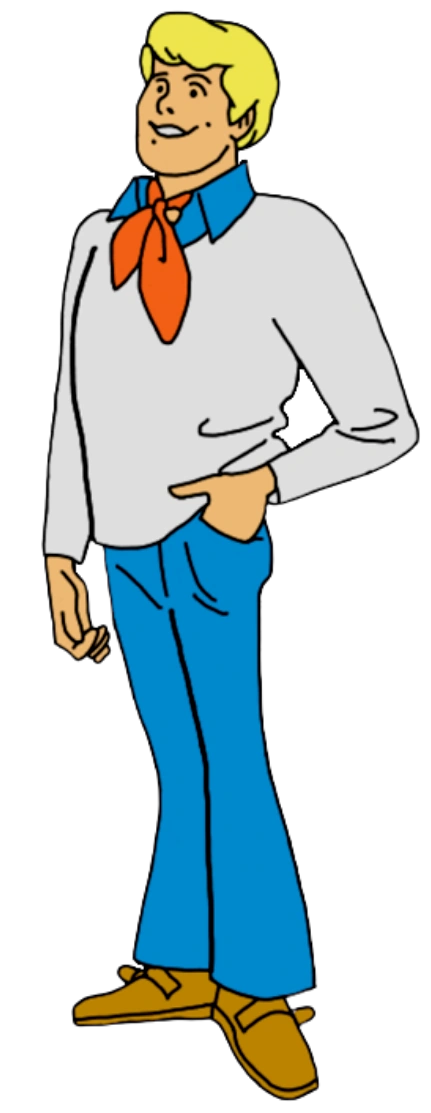
Fred is the one character from the core gang who has the least depth to him. As such, creating a character that is a homage to him is easy, because Fred could be absolutely anything; a point made in the video essay seen above.
Fred is often characterized as the leader of the Mystery Gang and that is it. Writers have tried to give him depth by giving him odd interests that are mostly written off as gags, the most infamously his fascination with booby traps and treasure. At his core, Fred is just a lovable himbo and sometimes that's all a character needs.
If I were to create a character based on Fred, he would be simple; just a guy who adores his girlfriend and her weird little interests, the "girlfriend" being the character I base off Daphne. All a character that references Fred really needs to have are those traits, and a whole lot of charisma.
Now that I have identified what makes each character uniquely themselves, I can now create characters that reference the original cast but are still distinctly new characters. The hypotheticals I put forth earlier will be the foundation I build these new characters upon. The next step from here would be research on how to effectively design characters in general.
Citation:
1. Crippa, J.A., Zuardi, A.W., Martín‐Santos, R., Bhattacharyya, S., Atakan, Z., McGuire, P. and Fusar‐Poli, P., 2009. Cannabis and anxiety: a critical review of the evidence. Human Psychopharmacology: Clinical and Experimental, 24(7), pp.515-523.
2. Hayatbakhsh, M.R., Najman, J.M., Jamrozik, K., Mamun, A.A., Alati, R. and Bor, W., 2007. Cannabis and anxiety and depression in young adults: a large prospective study. Journal of the American Academy of Child & Adolescent Psychiatry, 46(3), pp.408-417.
1 note
·
View note
Text
Eve Babitz
‘His voice was exactly like chocolate,’ Babitz writes in Eve’s Hollywood, of the married man who deflowered her in her teens. ‘It was like chocolate chocolate chocolate.’ For Babitz, there could be no greater compliment than a comparison to chocolate – the word alone appears seventeen times in the book, three more times than ‘sex’. ‘One of my dreams of childhood,’ she continues, ‘was opening a door and finding an entire room with nothing but chocolate in it, no air, all chocolate so that you had to chip off a piece with a knife just to begin. I have never wondered how the chocolate got into the room.’ Taking advantage of a situation without wondering how it came to be certainly feels like a signature Babitz move, and this early fantasy suggests that her go-for-broke approach to life began at birth. It hints, too, at her love of excess, the way she appeared to see her entire life as an enormous room filled with chocolate that she had to gouge and gorge her way through, never tiring or flagging, always bottomlessly famished.
― ― ― ― -
Eve Babitz's Hunger
A Taste More Primary Than Art Considers Proper. Words by Philippa Snow; Illustration by Sinjin Li
Reading about how people eat and what they eat is one of the great literary pleasures. Through the description of pace, the revelation of aversions, idiosyncrasies of seasoning and ticks of body language, a most intimate portrait emerges. So much is expressed – exposed even. Better still when such a portrait arrives with a keen sense of place and time; we can feel how our character rubs up against that which surrounds them.
For example, last week I revisited a piece by Irish writer Maeve Brennan from her ‘Long-Winded Lady’ reports of 1960s Manhattan life in The New Yorker. In the essay, later titled ‘Broccoli’, Brennan starts her account of a meal by describing the atmospheres of New York restaurants and how they vary according to the hour, before shifting to a forensic focus on a patched-up seat that somehow reveals everything about her, and the chain restaurant she’s dining in.
“One of the booths in that Longchamps has a patched seat. It is a booth that faces the back of the restaurant. The patch, of wide gray adhesive tape, is in the form of a Red Cross cross, square and definite. It is reassuring to think of the big Longchamps chain’s having recourse to such tiny, housewifely economy, and being so neat about it. I sat beside that patch the last time I was in the Fifty-ninth-Street Longchamps, so it must have been summertime then, because I would never agree to face away from the window except in the hot midsummer weather, which I hate.”
While in command of language, though, Brennan’s impulse order of ‘fresh broccoli with sauce suprême’ leaves her unable to perform her role of diner. After she declines the waiter’s help serving the sauce, she realises she does not know where she should put the sauce – on the tender stem or the floret? The dish is illegible to Brennan and she dare not go in with her knife and fork willy nilly; the waiter clears it away, uneaten.
I cannot imagine such hesitancy from Hollywood-born writer Eve Babitz, whose will-to-life via fucking and eating in 1970s LA leaps from the page in today’s newsletter by Philippa Snow. Contra the broccoli-shy Brennan and cool tone of Babitz’s West Coast rival Joan Didion, Snow shows us in full colour how Babitz’s oeuvre brims with insights that could only be won through her radical, full-throttle embrace of her appetites in her beloved Los Angeles – a city she maps out with meals and men, the same way it would be with meals and music by her unlikely LA successor, Jonathan Gold. RMJ
Eve Babitz’s Hunger, by Philippa Snow
Eve Babitz, the memoirist, novelist and hedonist, is typically categorised as a trailblazer because of her lusorious attitude to sex, both on the page and in her life. As a prose stylist, Babitz was pellucid, funny in the aphoristic way that every writer who desires to be funny longs to be, and truly hip. As a person, she was Too Much: ravenous, relentless, driven by her id, never dull because she never met a vice she didn’t like. A child (then a voluptuous, gloriously shameless woman) of Los Angeles, she wrote eight books in her lifetime, beginning with the impossibly cool and glamorous Eve’s Hollywood – a kind of proto-autofictional short story volume – and concluding with a slim book about tango dancing, Two by Two, in 1999. One of the things that she hungered for in perpetuity was sex, with men and every now and then with women, and her public image has been inextricably tied to the very famous men she’s slept with – Jim Morrison, obviously; Harrison Ford, obviously; Steve Martin, improbably – to the degree that she is often thought of as a groupie just as much as she is thought of as an author. When rereading her this summer, however, the picture of her that emerged had a subtly different focus, as if a seeing-eye puzzle had resolved itself and revealed some new formulation. Babitz’s writing about food, I discovered, is arguably even more uncompromising and transgressive than her writing about sex – just as much as fucks and crushes, her work revolves around restaurant culture and cuisine, her desire to be fed often equalling or eclipsing her desire to get laid. If her starfucking and her erotic anthropology have been raked over so much that there is no new ground to cover, the expansiveness of her literal appetite still has the power to surprise and thrill.
‘His voice was exactly like chocolate,’ Babitz writes in Eve’s Hollywood, of the married man who deflowered her in her teens. ‘It was like chocolate chocolate chocolate.’ For Babitz, there could be no greater compliment than a comparison to chocolate – the word alone appears seventeen times in the book, three more times than ‘sex’. ‘One of my dreams of childhood,’ she continues, ‘was opening a door and finding an entire room with nothing but chocolate in it, no air, all chocolate so that you had to chip off a piece with a knife just to begin. I have never wondered how the chocolate got into the room.’ Taking advantage of a situation without wondering how it came to be certainly feels like a signature Babitz move, and this early fantasy suggests that her go-for-broke approach to life began at birth. It hints, too, at her love of excess, the way she appeared to see her entire life as an enormous room filled with chocolate that she had to gouge and gorge her way through, never tiring or flagging, always bottomlessly famished.
An inability to enjoy one’s meals is often treated as a signifier of tedium in Babitz’s books, and as with her numerous bedfellows and their aptitude for sex, she privileges the company of those who share her passion for gastronomic indulgence. In 1979’s Sex and Rage – a ‘novel’ that is really more or less an autobiographical retelling of her tortured, sadomasochistic emotional fling with the record executive Earl McGrath, and her alcoholic flameout at the tail-end of her twenties – the Eve stand-in, Jacaranda, can think of no better way to write off her frenemy’s rich and supposedly elegant friends than by noting how impressed they are by flavourless, soulless cooking. ‘They demanded the same French food (what Jacaranda called “kosher fillet of sole”) in every city on earth,’ she writes, ‘and were suckers for going to bars and nightclubs and restaurants because their “dear friends” went, no matter how much better the place next door was.’ Contrast this with Eve’s eternal admiration for a friend called Connie in 1974’s Eve’s Hollywood: ‘a very sleek, dark, fashion girl who lends fastidious elegance to everything she touches… [and] can’t go a month without chili… [and] chorizo.’ A lover of glamour and gluttony herself, it is safe to assume that when Eve met Connie, game, as they say, recognised game.
0 notes
Text
Spaces between - Roundabouts the history of road signs.
From discussing ideas in yesterdays group task about our projects. I was suggested to look at a range of different sources which will help my practise. As I’ve briefly touched on looking at signage on roundabouts which I have experienced and look at in my primary research. I thought about looking a bit more deeply within the history and who and why they were made.
Before the 60s Britain’s roads were littered with a variety of different signs. All commissioned by different bodies. Herbert spencer noticed this whilst travelling along the A3. Realising all the different type faces colours and symbols. All being used to help us with safety within our roads. But this was becoming to messy and difficult to understand with the vast amount of different types. He wrote essays on how confusing and chaotic they were. He also noted how making them all easily read and understandable was so important. The government at the time developed a new system on signs. Which were created by Jock Kinneir. 1917 - 1994 and his assistant Margaret Calvert. There new signage system was and still is one of the most ambitious information design projects over undertaken in Britain.
All signs were introduced on the 1st of January 1965. They also only used 2 different typefaces for all signs. Both mix of upper and lower case letters. Which helps people recognise words faster than uppercase letters. Also they only use three different shapes Circles are used for signs which give orders. triangles used for signs that warn you about something and rectangles are used for signs that give you information. Here are some examples

http://britishroadsignproject.co.uk/jock-kinneir-margaret-calvert/
https://designmuseum.org/discover-design/all-stories/british-road-signs
0 notes
Text
THE IMPORTANCE OF WORKPLACE DESIGN FOR MOOD AND MOTIVATION
The major three for every office are mood, motivation, and productivity. However, did you know? Unbeknownst to you, office design has a significant impact on reaching these objectives.

In this essay, Arc Business Interiors examines how thoughtful and customised workplace design may increase worker motivation and concentration while also providing a fantastic return on investment.
Why is this crucial?
The majority of our lives are spent at work. This implies that in addition to feeling supported by our coworkers, we also need to feel supported by the environment in which we work.
Office layout significantly affects employees, having an impact on anything from creativity to general motivation and attitude. Therefore, putting in place the correct circumstances through careful space planning and design will boost both employee wellness and the calibre of your company's production.
Additionally, custom interior design that is appealing to the eye may help you earn a return on investment by drawing in and keeping talent (ROI).
Comfort is the foundation for productivity.
It seems to make sense that when we are at ease, we perform at our best.
Custom-made furniture is essential to creating a relaxing, ergonomically sound environment that promotes workers' physical well-being and avoids aches and pains that could impair productivity and staff comfort.
Furniture may also be carefully picked to match the design aesthetic and brand personality of your business, serving the twin purposes of boosting comfort and well-being and fostering a feeling of identity for the latter.
Establishing favourable circumstances
Employee alertness i maintainsed and distractions are kept to a minimum in environments with natural light, ideal temperatures, and low noise levels.
There are several methods to create this welcoming environment, such as switching out solid partitions for glass, paying attention to lighting design, and installing efficient heating and air conditioning systems.
Utilizing the area sensibly
Space design is crucial for determining how employees will interact with an office environment, and it's always necessary to give the working spaces just as much thought as the relaxing ones.
Employees would feel confined and have little room to unwind and cooperate in a crowded workplace with limited break-out areas, for instance. This might exacerbate tension levels and prevent the vital contact and creative thinking that are frequently primary advantages of these break-out places.
Therefore, a more open and well-organized design will directly impact staff morale, a sense of cooperation, and the ease of mobility within the workplace. There should be ample workplace room between workstations and dedicated break-out areas for collaborative exercises, relaxing, and socialising.
The theory of colour
According to research, colour has a significant influence on our mood, thus picking the right colour for your business is crucial. Your brand's colour scheme could already provide you with a solid foundation to build from and some basic tones to experiment with.
It's better to avoid using a lot of busy, wacky colours because they might distract workers. However, you might not want to go with an all-gray or all-white colour scheme, since this might make employees feel depressed or hopeless.
The best option is to use a few tasteful colour accents around the room to achieve the ideal balance between being neither overly distracting nor understated.
Define who you are
The notion that workspaces should readily convey the brand identity and attitude of the organisation to both workers and new visitors is a frequently ignored aspect of office architecture. A very dramatic and visually appealing approach to achieve this is through office design.
There are several methods to create a distinct identity via interior design, such as using your brand colours or including graphic elements that express your message.
If you do this skillfully, it will make employees feel like they are a part of a team and offer them a greater sense of purpose on a daily basis.
Encourage exercise and health
Mental and physical health are closely related. Helping personnel take care of their bodily needs is therefore likely to have a favourable impact on their attitude as well.
Simple solutions like installing water coolers and vending machines to keep staff members hydrated and fed can help with this.
It can also take the shape of more significant adjustments, such as adding a workplace gym or a canteen area to incentivize staff members to leave their workstations during scheduled lunch breaks.
How to Create a Future Office Environment's Experiences
About Us
Studio AsA - Residential interior designers in pune is an Architecture and Interior design studio created by design enthusiasts always curious about new design innovations. An association of young minds looking forward to bringing the transformation beyond dreams and imagination.
Address - 1st, 2nd and 3rd floor, Ashtagandha Bungalow Phase 3B, near The Rustle Nest Restaurant, Baner, Pune, Maharashtra 411045
Call Us - +91-93095 90430
0 notes
Text
Celebrate Independence Day in RES School
Any country that has been under the reign of a foreign government will surely know what life is like in that scenario and also the need for freedom. All those countries which have gained their independence from the rule of the foreign government would know for real how significant it is and hence commemorate the occasion. India is one such country that celebrates its day of independence on the 15th of August every year.
RES School celebrated Independence Day with great pomp and splendour as it was the 75th Independence Day. The entire school building was lightened up with the Tri colour lights for three days and the compound was representing the Indian flag colours.
The Independence Day function started at 8 o’ clock in the morning with Mr.Prasanna the chairman and Mr.Prashanth M.D of the School lighting the diyas and unfurling the national flag. Commencing the function, the chairman through his motivational speech shared the importance of Independence Day to students. He shared his thoughts that the foundation on which the Indian Freedom struggle was based i.e non- violence movement. This concept was taught to us by the great spiritual guru called Mahatma Gandhi or what we often address him as Bapu. The most significant aspect of our freedom is that it was won assertively and not through any aggressive practices. Today, we are still known as a nation which is an unruffled amalgamation of diverse values and cultures.
The event followed by the Dumble Drills and the Hoop Drills from the high school Students who presented themselves very beautifully. The choir group sang “Hindustanavu yendu Mareyada “showing their love and how pride they are of their nation.
The Pre Primary students had attired themselves as the freedom fighters and sang Vande mataram showing their love towards country.
This was followed by the speech from the Managing Director who advised the students to pledge and take part in nation building in our own unique ways. It is highly inevitable for all of us to uphold our rich traditions and cherish our culture. He said that our students are our Nation’s Ambassadors who can spread the richness of our values. To make this possible, they need to take extra efforts to understand our values and culture well. I am sure that your parents and teachers give you ample opportunities in this regard. Our dream is that each one of you growing up and developing as integrated personalities and becoming true global citizens who will return to your own country and contribute immensely towards its further development, and also for the world peace at large.
The event was continued with the cultural programmes from each of the classes and few speeches from students in different languages. The Programme was concluded by distribution of medals from the chairman and managing director to students who had participated in various events organised by school.
The celebration was planned for a week and the students had cooking without fire in tri colour, they decorated their notice board with the sketches of the freedom fighters and the Mid school children had their Essay writing on “Developing india”
The lower primary class students did art work putting forward their dreams about their country.
It was very surprising to see the students with such big thoughts for the country. We are proud that our students have great vision and will grow up to be good and proud citizens. Sweets and snacks were distributed for the parents, students and staff at the end of the programme
0 notes
Text
WEEK 10 REFLECTION
“Let us strive for, conceive, and create the new building of the future that will unite every discipline...” - Walter Gropius, Bauhaus Manifesto
Due to being sick with what was suspected to be covid (but thankfully was not) I was unable to attend class this week, however I did manage to catch up on the lecture via MS Teams and the SDL tasks via Canvas. I unfortunately did not find much time to complete a lot of work this week because I was sick but I did manage to write a draft introduction.
In the lecture, Becky introduced us to the history and importance of the Bauhaus. As someone who is quite fond of modernism, this was a very enjoyable lesson.
The Bauhaus was founded by architect Walter Gropius in Weimar in 1919 and was influenced by William Morris’ socialist principles. He believed in the unification of art and design (as these were seen as two different things at this time), that good design should be accessible to everybody, and that there should be a place for people from all walks of life to create and experiment with a focus on community. The Bauhaus was only active for 14 years, up until 1933 when its operations came to a close, which is quite remarkable to think about considering the influence it had (and still does) on the world. During its time, along with working very hard, the students and staff would put on very theatrical parties and performances, they played with gender identity, and was overall thought to be rather ‘outrageous’ to the general public.
The curriculum for the school was something that had not been seen before. Students would do a 6 month preliminary course to de-learn/re-learn tradition, followed by a 3 year workshop course which would see the more talented students find work as assistants in Gropius’ office, and finally having the opportunity to become a master/teacher at The Bauhaus.
There was an exercise in this lecture which required assigning the three primary colors (yellow, blue, red) to a circle, triangle and square, based off Wassily Kandinsky’s form + colour teachings where he believed in a universal visual language. Kandinsky, alongside Paul Klee, ran a workshop within the preliminary course at the Bauhaus. My personal interpretation, before learning Kandinsky’s, came from this marriage of the name of the colour and the form of the shape, so:
The triangle is yellow - sharpness of both the shape and letter forms in ‘yellow’
The circle is blue - the softness of the circle form and the ‘serene/calm’ symbolism of blue (which ‘blue’ also has this organic roundness to it)
The square is red - the rigidness of the shape and blockiness of the word ‘red’
Unfortunately, for all of Gropius’ progressive beliefs, he thought that women's minds were different to mens, therefore othering them in the school, which is such a shame to hear. In the beginning, 51% of the students were women and they were only allowed to advance to workshops in textiles and weaving, so it’s super frustrating to hear about this kind of sexism happening in a place that you’d think would be the complete opposite. Annie Albers became the head of weaving in 1930 at The Bauhaus and is a well known artist from this period. Marianne Brandt defied any of these notions and pursued a metalwork practice, eventually becoming an assistant and one of the most successful Bauhaus students (so cool!!)
The SDL for this week is to continue writing our essays so that we have a full draft in time for next weeks lesson.
1 note
·
View note
Quote
Blue water is invariably salty, warm, and deep and speaks of the tropics, where evaporation is great and dilution minimal—the Sulu Sea, the Indian Ocean, the Gulf Stream. Green water, on the other hand, is cool, pale with particles, thin with river and rain, often shallow. In the tropics it means land, just as in the north, with white jigsaw ice, it means a frozen bay is not far away. Water is always mysterious. “I used to wonder why the sea was blue at a distance and green close up and colorless for that matter in your hands,” writes Sr. Miriam Pollard, O.C.S.O., in The Listening God. “A lot of life is like that. A lot of life is just a matter of learning to like blue.”
Alexander Theroux, from “Blue”, The Primary Colours: Three Essays
#lit#quotes#words#essays#Alexander Theroux#The Primary Colours: Three Essays#the world is blue at heart#the sea the sea#on nature#favourites#m
442 notes
·
View notes
Photo
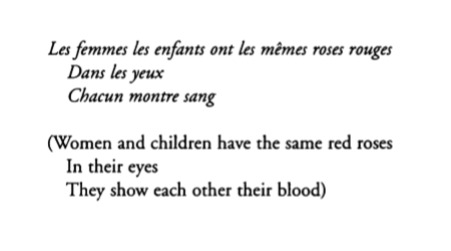
Paul Éluard, ‘La Victoire de Guernica’, as quoted in Alexander Theroux’s The Primary Colours: Three Essays
#lit#quotes#poetry#paul eluard#french#bilingual#la victoire de guernica#typography#alexander theroux#the primary colours: three essays#reading#m#x#is this a queue which i see before me?
181 notes
·
View notes
Text
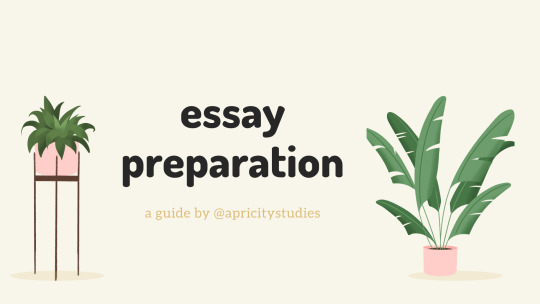


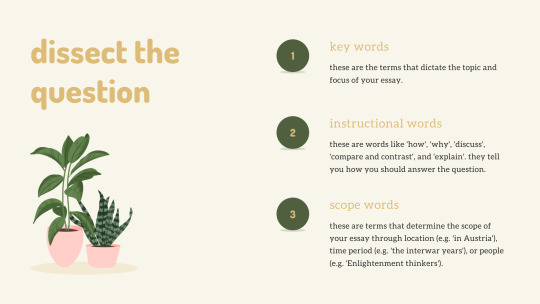
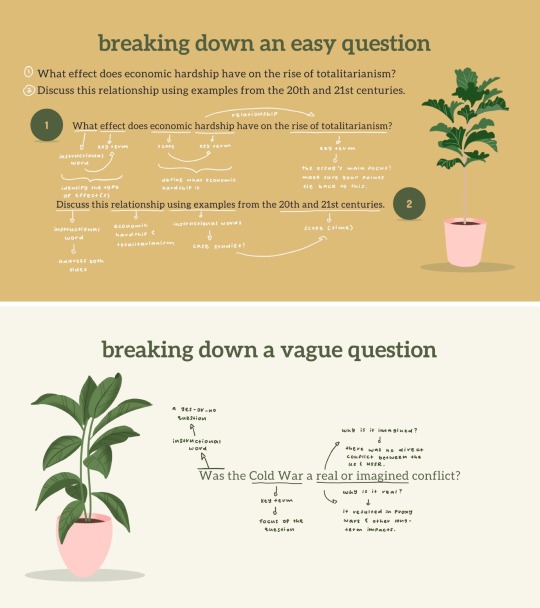

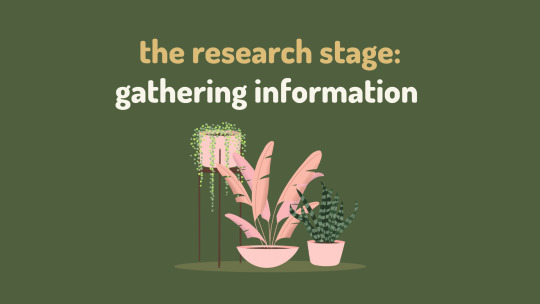

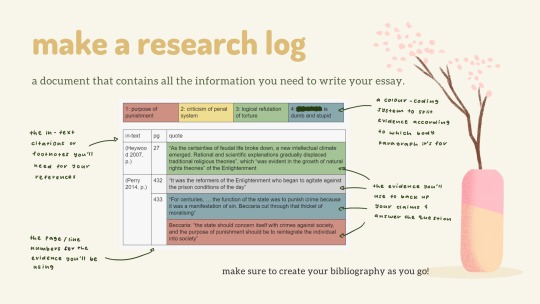
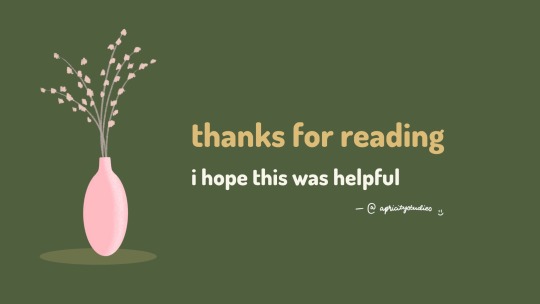
every minute spent on planning saves you ten minutes spent on execution. short essays probably don't require that much preparation beforehand, but if you're writing something longer you should probably spend some time planning first. this is the process i go through when planning my essays, and i find it works really well!
transcript below:
essay preparation: a guide by apricitystudies
(section one) the planning stage: getting ready to write
1. understand the requirements: all the things you need to know before you start doing anything else. what’s the word count? how many and what types of sources do you need to use? what’s the required referencing style? what criteria will you be graded on?
2. dissect the question by examining three types of terms. key words, or terms that dictate the topic and focus of your essay. instructional words like ‘how’, ‘why’, ‘discuss’, ‘compare and contrast’, and ‘explain’, which tell you how you should answer the question. scope words, which determine the scope of your essay through location, time period, or people.
(next are two examples which i annotated by hand, so i’ll try my best to express them in text form! sorry if the meaning is unclear.)
example 1: breaking down an easy question. what effect does economic hardship have on the rise of totalitarianism? discuss this relationship using examples from the 20th and 21st centuries. here, ‘what’ is an instructional word and ‘effect’ is a key term -- the question is asking you to identify the types of effects. ‘economic hardship’ and ‘the rise of totalitarianism’ are key terms, and this is the relationship the question is focusing on. ‘discuss’ and ‘using examples’ are instructional words telling you how to got about identifying the effects in this relationship. the ‘20th and 21st centuries’ are scope words.
example 2: breaking down a vague question. was the cold war a real or imagined conflict? ‘was’ is an instructional word telling you that this is a yes-or-no question. ‘cold war’ is a key term and the focus of the question. (end of examples)
3. creating an essay plan, which comprises three parts. a working thesis, or how you will answer the question, the main points of your essay, or how you will prove your thesis is true, and the order of those points, or how you will organise your answer.
an example essay plan based on the earlier question: was the cold war a real or imagined conflict? working thesis: the cold war was a real conflict because it had real, unquestionable, and lasting impacts. main points in order: the impact off the arms race on modern nuclear arsenals, the impact of the korean and vietnam wars, and the impact of the ideological division of europe. this is a highly oversimplified plan! (end of example and planning section)
(section 2) the research stage: gathering information
1. determine what you need to know using these three questions to help narrow the scope of your research. what types of sources do you need? (e.g. journal articles, primary sources, books, etc.) what information are you looking for? what evidence do you need to back up your main points?
2. make a research log: a single document that contains all the information you need to write your essay. below is a screenshot of a table. the top row is a colour-coding system to split evidence by body paragraph. below, the left column is for in-text citations or footnotes for each source. the next column is for the page numbers of each quote. the final and largest column is for the quotes or evidence themselves.
final note: make sure to create your bibliography as you go!
final slide: thanks for reading! i hope this was helpful. from, apricitystudies
#studyblr#studyspo#productivity#motivation#student#organization#essay writing#study tips#university#studyblrmasterposts#studyblr masterpost#studyspiration#serendistudy#sonderstudy#problematicprocrastinator#itshannyb#gloomstudy#myinfo
14K notes
·
View notes
Text

I. Between blue and purple (photograph)
II. Love is blue. A clear cerulean when new. A bright, bold, true blue in its glorious throes. And when it hurts, as it inevitably will, love turns deep, dark, the color of a bad bruise.
Nina Malkin, Swear

III. God's Own Country, Francis Lee (2017)
IV. “The deeper blue becomes,” wrote Kandinsky in On the Spiritual in Art, “the more urgently it summons man towards the infinite, the more it arouses in him a longing for purity and, ultimately, for the supersensual.” The color indeed, like Goethe’s Eternal Woman, like mystery itself, seems to beckon us ever and ever onward, becoming, in Kandinsky’s words, “the infinite penetration into the absolute essence—where there is, and can be, no end.”
Alexander Theroux, from “Blue”, The Primary Colours: Three Essays

V. Wolfgang Mattheuer (German, 1927-2004), Abenddämmerung [Dusk], 1991. Oil on canvas, 60 x 80 cm.
#blue#a feeling for blue#blue paintings#cinema photography#oh man yeah#so many ways#blue literature#artists on tumblr#cinephiles#cinephile#cinephotography#blue painting#one time I watched#blue is the mood#blue is the warmest color#the color of love
35 notes
·
View notes
Text
Some readings about colours and colour theory
Articles:
10 ways to look at the colour black
The crayola-fication of the world: How we gave colours names, and it messed with our brains part I II
Seeing Cerise: Defining Colours in Webster’s Third
The Rich and Royal History of Purple
Colour or Fruit? On the Unlikely Etymology of “Orange”
How Beets Became Beet-red
How Colour Shapes Our Lives
In defense of the world's ugliest colour, "Opaque Couché"
A Brief History Of Ultramarine: The World's Costliest Colour
The Histories of 10 colours through multiple lenses
From Gemstones to Arsenic: How Development of Pigment Colored Art
A Collection of 3000 pigments made from cow urine, shells and insects and more
The Red of Painters
The Secret Literary History of Some Of Your Favourite Colours
Goethe on the Psychology of Color and Emotion
A series on history of some common colours
A series on history of uncommon colours
Some more columns on unusual colours
Further reading:
The Theory of Colour, Goethe
The Secret Language Of Colours, Joann & Arielle Ekstut
Interaction of Color, Josef Albers
The Secret Lives of Color, Kassia St. Clair
Werner's nomenclature of colours
Blue: The History of a Colour, Michel Pastoureau
The Primary Colours: Three Essays, Alexander Theroux
The Perfect Red, Amy Butler
The Brilliant History of Color In Art & Colour: Travel Through The Paintbox by Victoria Finlay
On Color, David Scott Kastan with Stephen Farthing
#obviously not a comprehensive list but i added as many as i could remember and find#as for the books the links are to the Goodreads page#i didn't have the energy (and wifi) to find the pdfs of all but feel free 2 ask and I'll send it to you!!!#I love doing things no one asked for for example this whole post#ref#resources#articles#books#readings#colours#colour theory#btw the only way 2 spell colours is with a u#mine#art history#art#ref: mine
3K notes
·
View notes
Note
Wow I had never seen the "Imagine different coloured hands" thing. I feel so disgusted right now. How can a person be so bland and voluntarily disconnected from reality, ffs. Guess H hasn't found any cause to really support because the solution is as simple as imagining...
Racism, misogyny, and intolerance can all be as bland as saying, “They’re too sensitive,” “They’re exaggerating,” “All lives matter,” “I have a black friend,” “There was no intentional racism meant.”
Here’s the link to the post.
Let’s look at the Grammys and the statistical probability of a POC winning an award in the top four categories.
There have even been cases where both critically acclaimed AND commercially successful works didn’t win Grammys. Why are the Grammys still failing to recognize them? Based on anecdotal and empirical evidence, one of the primary culprits is almost certainly systemic racism. Many of the most notable Grammy snubs recently were for Black hip hop and R&B artists; in fact, only two hip hop albums have ever won AOTY.
In the world of Ben Winston and his bland, casual racism, this essay by a black female executive in the industry is always worth reading.
13 notes
·
View notes
Text
So I Want to Be a Game Designer #1 - Once Upon a Tower
Introduction
Hello, reader.
Welcome to a new series, “So I Want to Be a Game Designer”! In this series, I will be analyzing a game to identify its mechanics, dynamics and aesthetics to determine if the game successfully facilitates Meaningful Play.
The game I will be analyzing in this post is Once Upon a Tower, a roguelike game designed for mobile on both Android and iOS. In this game, you are a princess who has been detained at the top of a tower. When a knight’s failed attempt to rescue the princess results in her gaining a weapon, she uses the weapon to facilitate her escape from the tower and the evil dragon who guards her.

While this game has a straightforward objective, there are many aspects that work together to make the game challenging and fun. In the following sections, I will be covering the game’s:
Core Loop
Mechanics
Dynamics
Aesthetics
Meaningful Play
Core Loop
The core loop consists of the main activities that players will use continually throughout the game. In Once Upon a Time, those core activities can be boiled down to two things:

Every action the player might take on their quest to escape the tower (i.e. descend) can be encompassed by the term “overcoming obstacles.” As the player makes their way through each level, they must destroy blocks in their way, avoid or defeat enemies, and perhaps collect fireflies and purchase power-ups. No matter how the player chooses to go about navigating the level, the fact that they must overcome obstacles remains.
Likewise, after overcoming the obstacles in their way (no matter how they choose to do it), the player must then descend the tower. This is the goal of the game, and an action that will be repeated throughout its entirety.
Mechanics
Mechanics are game rules that are designed to constrain and influence the player’s actions within the game so that it is played as intended. There are three main types of mechanics:
Space Mechanics - has to do with the environment
Object Mechanics - things within the environment that can be seen or interacted with
Action Mechanics - things the player can do
Core Mechanics
The core mechanics are those that are fundamental to the player’s experience; without these, the game would be completely different.
Gravity (Space Mechanic)
The character falls through open spaces in the map to progress through the level
Swinging the Weapon (Action Mechanic)
Serves several functions: breaking blocks, collecting fireflies (currency), and attacking enemies
The action of swinging the weapon is integral to the core gameplay because the player cannot progress without at least breaking blocks
Levels (Space Mechanic)
The only way the player can progress through the game and win it is by advancing through the levels. Without the level structure, the game would be fundamentally different
Non-Core Mechanics
The non-core mechanics, while important for furthering the core theme, are those that the game can exist without if they were to be replaced. For example, the enemies do not have to be dragons and ogres; they could be replaced with zombies and skeletons and the core of the game would remain the same.
Space Mechanics
Barred Windows - A space in the tower walls that the dragon will breathe fire through to attack the player. The player cannot interact with them, so they aren’t really an “object” in the game. The effect of the dragon attacking through them is activated when the player stands on the same horizontal plane as the metal bars.

Object Mechanics

Bricks - An obstacle the player must destroy to progress through the level
Rubble - Weak blocks that will crumble when the player stands on them, causing the player to fall through (usually to traps waiting below)
Spikes - An obstacle that kills the player when landed on (without certain power-ups)
Piston - An obstacle that periodically pistons a log vertically or horizontally to crush the player if they do not time their movements correctly
Power-ups - Purchased with fireflies between levels
Defensive buffs to prevent damage from attacks or obstacles (e.g. the armoured boots will prevent damage from landing on spikes or crabs (who have spikes on their backs))
Offensive buffs will augment the player’s weapon or give them an extra ability (e.g. the fire hammer will give the player ranged attacks, or bombs will destroy enemies and obstacles on a large scale)
Other buffs will aid in the players traversal of the obstacle course (e.g. the parachute slows down the character’s fall and allows movement when descending
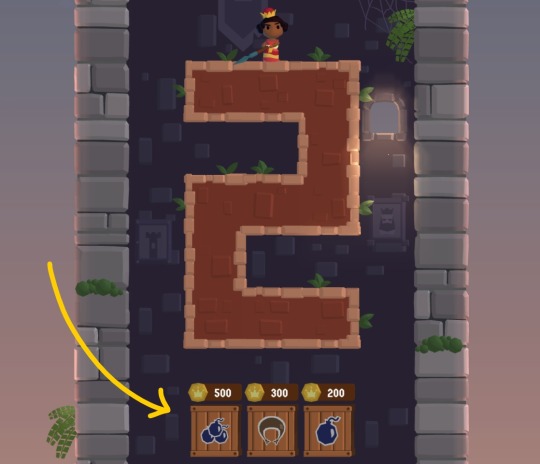
Fireflies - in-game currency and points. During a level, the player can use collected fireflies to purchase power-ups. After exiting a level, the fireflies earned will be converted into stored points which can unlock new character avatars.
Diverse Enemies - Each enemy has unique behaviour, and require different strategies for countering them:
Ogre
Hyena
Spider
Crab
Baby Dragon
Action Mechanics
Movement - The player moves one block at a time by the player swiping in any direction on their screen (left, right, up, and down)
Swiping Left or Right: Moves the character one space in the indicated direction
Swiping Up: Causes the player to jump and swing their weapon at the space above their head
Swiping Down: Causes the player to break the block in the space beneath them (if there is one), which is how they can utilize gravity to descend the tower
Dynamics
These are the ways players can utilize the mechanics to play the game; i.e. the gameplay. Dynamics include strategies the players can develop based on different game mechanics.
Timing
The player needs to select the right moment to break blocks or move past obstacles to avoid getting caught

Utilizing Enemies
Some enemies will fight each other if close enough together. Players can attempt to turn them against each other by pushing them closer with hay bales or breaking blocks
Managing Currency
Do you buy a powerup now or save it for more expensive items in later levels?
Spatial Reasoning
The player must be aware of their surroundings so that they can properly react to obstacles (especially the dragon, which will breathe fire through barred windows)
Collection
Do you prioritize collecting fireflies in order to get power-ups? Or do you ignore them in favour of taking out enemies at a more advantageous time?
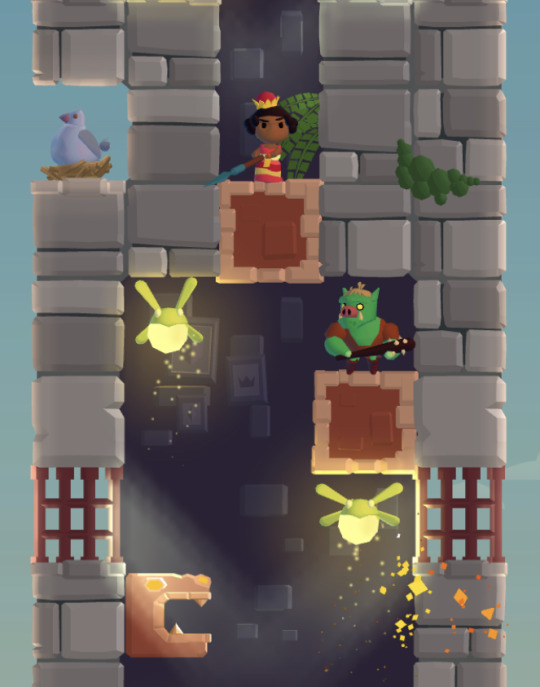
Aesthetics
Once Upon a Tower is primarily trying to engage the player’s competitive spirit and sense of discovery. Many of the game's mechanics and dynamics are ideal for players who enjoy a challenge and like playing to beat their best score.
Challenge
The player is issued a high score at the end of each play session, so they are encouraged to play again to beat their own score
Obstacles are tricky, so when the player is bested by a level, they are left with the competitive urge to try again until they can overcome it
Escape progress (beating all the levels) is tracked per princess. This encourages players to continue playing the game with each princess to feel the satisfaction of “100% completion”, which can be considered as completely beating the game
(No noticeable narrative to interfere with a competitive player’s desire to get right into the gameplay)

Fantasy
The game is set in a fantastical environment with mythical medieval enemies (such as dragons and ogres)
The cartoon style of the graphics keep the game feeling whimsical and fun, so that the player will not be distracted from the core gameplay
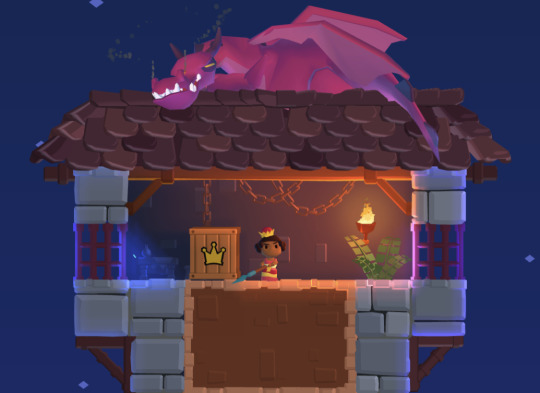
Discovery
The player is constantly learning new things during each playthrough and each level. Every time the player restarts at the top of the tower, the layout is regenerated for a fresh experience. Furthermore, as the player goes from one level to the next, they will encounter new enemies and obstacles to overcome.
Once Upon a Tower has a colourful, cartoon-like art style typical of indie games. The art style fits well with the medieval fantasy setting, so that the player can be immersed in the simple narrative of a princess trying to escape a tower.
The style of the art and animations upon defeat are very lighthearted. This keeps with the primary theme of keeping the player engaged in the challenge aspect of the gameplay, rather than a tragic narrative. The game is meant to be something that can be picked up and played immediately, not something that requires the player’s focus on uncovering a complex story. The upbeat background music and sound effects only add to the player’s feeling of lighthearted fun.

Meaningful Play?
“Meaningful play occurs when the relationships between actions and outcomes in a game are both discernable and integrated into the larger context of the game. Creating meaningful play is the goal of successful game design.”
—Salen, K., & Zimmerman, E. (2004). Chapter 3: Meaningful Play. In Rules of Play: Game Design Fundamentals (pp. 4–4). essay, The MIT Press.
The game mechanics and dynamics in Once Upon a Tower are able to achieve meaningful play in several regards. For example, the blocks the player chooses to break (i.e. the route they choose) to navigate the level can determine whether they can collect fireflies or safely overcome obstacles. Collecting enough fireflies will allow the player to purchase power-ups between levels. Certain power-ups will make the later levels much easier to complete, such as armoured boots or a shield, which is why the player’s decision to collect fireflies in the early levels and save them for purchasing more powerful buffs will have an integrated effect on their gameplay.
The medieval fantasy setting of the game was a good choice considering that gravity was a core mechanic. Any tall building world works well with the concept of the game. However, the aesthetic genres are able to work in conjunction to create a game environment that makes sense. The fantasy setting facilitates the use of the castle tower as well as the designers’ creativity when choosing monsters and obstacles. These obstacles are what turn the game into something challenging, and the diversity among them is what allows the player to explore uncharted territory.
The combination of all the aforementioned mechanics, dynamics, and aesthetics certainly do give rise to meaningful play.
Conclusion
Once Upon a Tower is a game that is able to facilitate Meaningful Play by a combination of its mechanics, dynamics, aesthetics, and overall design decisions. For those who have a competitive nature, this game will likely prove to be an addicting pastime due to the challenge it poses. Many of the game's mechanics, such as the obstacles, diverse enemy types, and the level-based structure of the game will keep the player engaged. The use of upbeat music and colourful visuals give the game a sense of lightheartedness that will immerse the player in the role of a plucky princess trying to escape a tower against all odds.
Credits:
All screenshots are of in-game elements from Once Upon a Tower. I claim no ownership over the image contents or the game itself.
1 note
·
View note